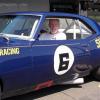In 1975, there were few really good white-metal or resin kits as the Japanese had not begun yet, the John Day or other British kits were rather crude, and the only good ones came from France, mostly from Andre-Marie Ruf (AMR).
Several top-notch model makers were hired to produce the new kits, that were to be manufactured in Costa Mesa, California under the name IMRA, or "International Model Racing Association". Famed pattern maker Lloyd Asbury, who had produced most of the Lancer slot car body molds in the mid-1960's and more recently the maker of most of the Action Performance patterns, was in charge of making the intricate parts that would make up these kits, that would establish new standards in the business. Other craftsmen were also hired, including Yours Truly who devised the packaging and drew the assembly instructions as well as painted the cover picture of the press kit. The introduction press kit was also spectacular, with extensive pictures and a description of the extensive manufacturing program of all the Indy-winning cars since 1911...

Reeves Whitson was not an unknown figure in the business: in 1967, he had attempted to organize the manufacturers of racing cars based in the UK (Lotus, Brabham, McLaren etc.) into an organization he would run in the attempt of licensing model car companies and paying royalties to the manufacturers. Indeed few were, and I personally recall how none of the kits I designed for the Heller company were licensed, but it was never in question at the time as both MATRA and Alpine were in fact very happy about having models made of their cars and provided all the needed information I wanted.
In 1970, Whitson moved to the USA and began organizing a similar setup for American vehicles, but that faltered. However, he had serious connections, and was able to help Maurice Philippe, and Yours Truly to obtain US permanent-resident status, and leased us from his company, Maurice to Vel's Parnelli Jones and me to my employer at the time, the Cox Hobbies company.
When IMRA was founded, Whitson's connections got him a favorable introduction to Tony Hulman, and the kit was introduced at the IMS shortly after Bobby's win. The meeting was reported by several local newspapers:

And indeed, the finished product was truly beautiful and established a new threshold for any and all kit manufacturers:

Detailing in the kit was unheard of in that scale:


The cast body and wing, the etched-metal steel pan and wing fences and small detailed parts were factory painted in the correct Jorgensen blue color. Extremely fine and very accurate decals (I saw to that, since i was in charge of the decor of the full-size car), as well as vacuum former seat and clear windshield were included.
Extensive and well illustrated instructions were enclosed. Parts rested on a vacuum formed tray.





This adventure began rather well, but did not end that way. Shortly after the production of the kits began and as the prepaid orders flowed in, disagreements between the partners took place and in a very short order, the venture was simply abandoned. It is estimated that no more than 200 kits were actually delivered before the entire venture collapsed.
The subsequent kits were never produced by IMRA but by a friend of Lloyd Asbury, who had a small model company called Marque Miniatures. There, the Coyote-Foyt, McLaren M16 and a few others were produced, and while their packaging never reached the level of the original, they sold to discriminating collectors. They are still to this day, the most detailed kits in that scale I have seen, as the current Japanese kits casting quality is still not to that level, their greater detail coming from the use of added metal-etched parts or wiring.
I never had an IMRA Eagle kit until... this week, when I was able to purchase one at a reasonable price. In the day, I did not care, so never got one. So the pictures posted here tell a bit of what it looked like, 36 years ago...
Is it not a beauty?
Edited by T54, 16 August 2011 - 20:05.













